Conversational Commerce Platforms Benchmarking in 2024
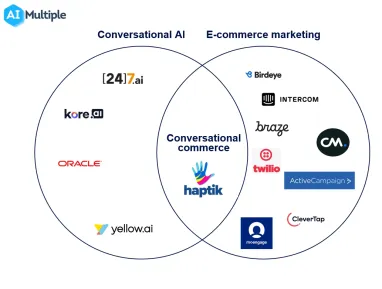
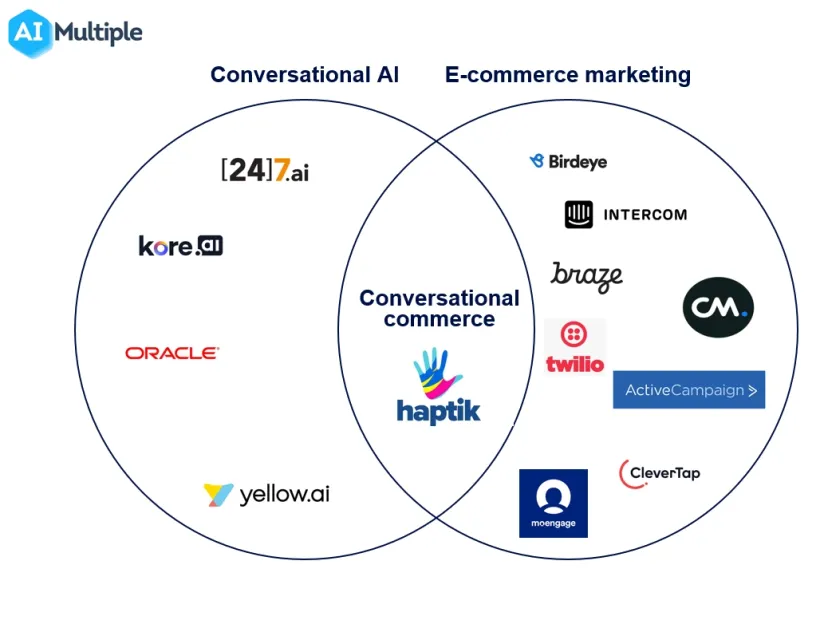
In 2021, e-commerce generated almost 4 trillion USD global revenue,1 which is greater than Germany’s economic activity.2 Despite its economic potential, increased rivalry among e-commerce businesses requires them to set themselves apart from their competitors by utilizing mass messaging and conversational AI solutions.
Accenture, for instance, found that almost 80% of CEOs3 want to completely change their customer relationship strategy. Conversational commerce can help businesses:
- Interact with their customers on digital channels (like WhatsApp) to engage with them.
- Help clients to discover new products thanks to intent recognition.
- Notify clients about the discounts, new products, delivery details etc.
- Automate answering customer queries.
Finding the right vendor is essential for a successful digital transformation towards conversational commerce. Though there are many conversational commerce platforms, it might be difficult to find a qualified vendor who provides the capabilities e-commerce enterprises need. The goal of our benchmarking is to fill the knowledge gap in this field.
Our analysis found that the market consists of 3 buckets: conversational AI, e-commerce marketing and conversational commerce.
Read on for our data-driven analysis of the market:
8 Key capabilities for conversational commerce platforms benchmarking
Conversational commerce is at the intersection of conversational AI and e-commerce marketing solutions. We identified the key, high-level capabilities (see Figure 2) in these domains from the perspective of an e-commerce operator that needs to optimize revenues and customer satisfaction while leveraging a natural language interface.
Figure 2: Key capabilities we determine for benchmarking analysis.
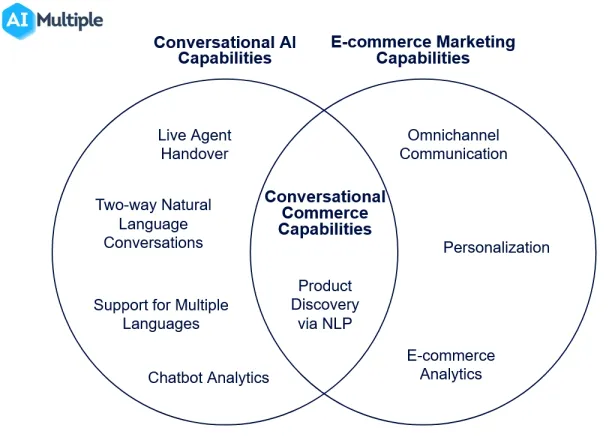
E-commerce marketing capabilities
1. Omnichannel communication
According to McKinsey,4 around 35% of Americans complete omnichannel transactions and this number is on the rise. Therefore, conversational commerce platforms should have capability to engage with customers via:
- SMS.
- Email.
- Messaging apps like Whatsapp, Facebook Messenger etc.
- Social apps like Twitter, Instagram and so on.
- Mobile apps.
- Websites.
2. Personalization
According to McKinsey’s survey,5 more than 70% of customers expect personalized marketing from the businesses and brands that outperform in personalized marketing make 40% more sales. Therefore, the capabilities of informing customers concerning:
- New products.
- Products that customers potentially like (according to previous transactions).
- Payment details.
- Shipping details.
- Discounts and more.
should be provided by conversational commerce platforms.
3. E-commerce analytics
To improve the effectiveness of their campaigns, e-commerce companies have to reach a granular understanding of their previous campaigns such as bounce rate, % of engaged customers etc.
Conversational AI capabilities
4. Two-way natural language conversation
Most marketers still rely on one way promotional messages. However, customers demand interactivity. Around 70% of people find two-way conversations pleasant.
To achieve two-way communication in natural language, a chatbot needs to be able to understand user intent and respond effectively (see Figure 3).
Figure 3: An example of 2-way natural conversation.

5. Support for multiple languages
Whether you focus on a local or international market, having a multilingual marketing campaign is beneficial for e-commerce companies. Because, due to migration there are diversities even in local markets. Thus, for e-commerce companies it is important to find a conversational commerce platform that supports as many languages as possible.
6. Live agent handover
According to McKinsey’s survey,6 20% of people still value human touch while engaging with businesses. Moreover, chatbots can fail and even if they do not fail, with current technology they are not able to automate 100% of customer queries. Thus, live agent handover is a valuable capability for conversational AI firms.
7. Chatbot analytics
Similar to e-commerce analytics, businesses need granular chatbot analytics such as human takeover rate, goal completion rate and so on to evaluate effectiveness of their conversational commerce investments.
Conversational commerce capabilities
8. Product discovery via Natural Language Processing (NLP)
Buyers may be familiar with their problem (e.g. leaking roof) but not familiar with the products involved in the solution (e.g. roof shingles, tar). Product discovery with NLP supports customers to find a suitable products and improve self service rates via:
- Informing customers concerning different types of substitute products and recommending the most suitable one to the customer according to their answers through their conversations with sales chatbots (see Figure 4).
- Helping customers discover new products based on their needs.
Figure 4: An example of product discovery via NLP.

What are other important criteria in selecting conversational commerce companies?
There are hundreds of conversational AI and e-commerce marketing companies and a capability based review of hundreds of vendors will either:
- Take years or
- Not go into the details of capabilities.
So we applied the 3 steps screening process to reduce the number of vendors we analyze.
Screening
We identified public, verifiable and relevant criteria that are correlated with a company’s revenues and conversational commerce offerings:
- Number of employees: Is highly correlated to revenues for companies working in the same domain. We rely on the company’s number of employees on Linkedin as a proxy for the company’s total number of employees.
Our initial focus is on companies with 500+ employees on Linkedin that have at least one Fortune 500 reference (e.g. Tata Cliq, Mondelēz, Coca-Cola7). Also, The vendors’ solution pages should mention e-commerce and/or retail and demonstrate at least 3 customers/case studies relevant to conversational commerce.
Note: We might have missed some conversational AI or e-commerce marketing platforms with relevant capabilities. If that is the case, please write a comment, and we would be pleased to add them to our research.
Which vendors provide these capabilities?
Conversational AI vendors claim to offer all conversational commerce capabilities except product discovery via natural language. Exceptions include these; we were not able to verify online that:
- Kore.ai offers e-commerce analytics
- Birdeye offers chatbot analytics
E-commerce marketing vendors claim to offer all conversational commerce capabilities except these:
- Product discovery via natural language
- Two-way natural language conversation
- Live-agent handover
- Chatbot analytics
- Exceptions include ActiveCampaign & CM.com claiming to offer two-way natural language conversation capability and Twilio claiming to offer live-agent handover & chat analytics capabilities
Conversational commerce vendor claims to offer every conversational commerce capability.
A representative list of vendors with unique capabilities for conversational commerce is shown in Figure 5.
Figure 5: Which vendors provide which distinctive capabilities.
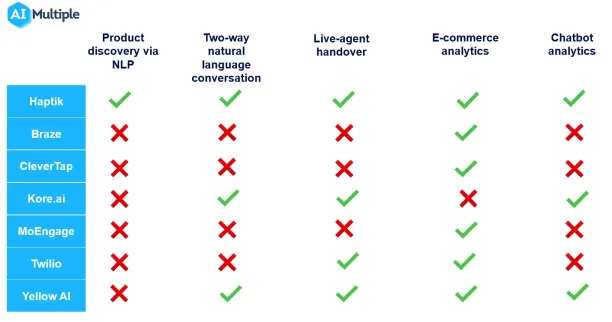
Further readings
- Top 7 Conversational AI Platforms of 2023: Detailed Guide
- Chatbot / Conversational AI Platforms
- Top 3 Yellow.ai Alternatives & Competitors Detailed Guide
- Top 3 Kore.ai Competitors & Alternatives
- Top 5 WhatsApp Business Partners.
Finally if you need further assistance to find right conversational commerce platform you can reach us:
External Links
- 1. eCommerce – Worldwide. Statista. (2022).
- 2. Germany: Gross domestic product (GDP) from 2010 to 2021. Statista. (2022).
- 3. The future of customer conversation: More than words, more than AI. Accenture. (2021).
- 4. Omnichannel: The path to value. McKinsey. (2021).
- 5. The value of getting personalization right—or wrong—is multiplying. McKinsey (2021).
- 6. What’s next for digital consumers. McKinsey. (2021).
- 7. Raj Koneru CEO of Kore.ai on Conversational AI in the Enterprise Today and Where It’s Headed – Voicebot Podcast Ep 252. Voicebot AI. (2022).

Cem has been the principal analyst at AIMultiple since 2017. AIMultiple informs hundreds of thousands of businesses (as per similarWeb) including 60% of Fortune 500 every month.
Cem's work has been cited by leading global publications including Business Insider, Forbes, Washington Post, global firms like Deloitte, HPE, NGOs like World Economic Forum and supranational organizations like European Commission. You can see more reputable companies and media that referenced AIMultiple.
Throughout his career, Cem served as a tech consultant, tech buyer and tech entrepreneur. He advised businesses on their enterprise software, automation, cloud, AI / ML and other technology related decisions at McKinsey & Company and Altman Solon for more than a decade. He also published a McKinsey report on digitalization.
He led technology strategy and procurement of a telco while reporting to the CEO. He has also led commercial growth of deep tech company Hypatos that reached a 7 digit annual recurring revenue and a 9 digit valuation from 0 within 2 years. Cem's work in Hypatos was covered by leading technology publications like TechCrunch and Business Insider.
Cem regularly speaks at international technology conferences. He graduated from Bogazici University as a computer engineer and holds an MBA from Columbia Business School.
To stay up-to-date on B2B tech & accelerate your enterprise:
Follow on
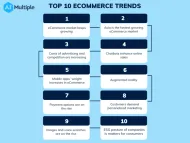
Comments
Your email address will not be published. All fields are required.